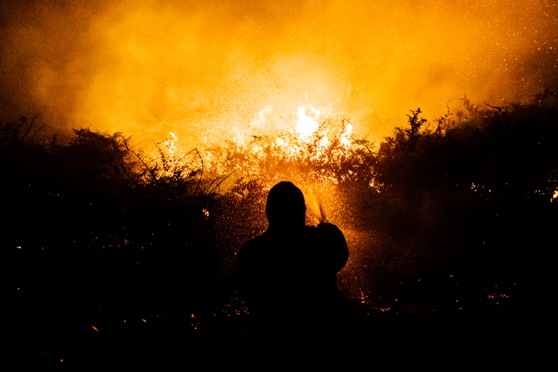It’s not just the West, these places are also on fire
By Veronica Penney
Wildfires are devastating the American West, but the United States isn’t the only place on Earth that’s burning. This year, other countries have also experienced their worst wildfires in decades, if not all of recorded history.
In each case, the contributing factors are different, but an underlying theme runs through the story: Hotter, drier seasons, driven by the burning of fossil fuels, have made the world more prone to erupt in flames.
“We don’t have a fire problem; we have many fire problems,” said Stephen J. Pyne, an emeritus professor at Arizona State University who studies wildfires and their history. “One, obviously, is a deep one. It has to do with fossil fuels and climate.”
Here’s a look at some of the worst recent blazes and how humans played a role in them.
— The Arctic and Siberia
The Arctic as a whole is experiencing warming at more than twice the pace of the rest of the world. Record-low snow cover, high temperatures and dry soils, almost certainly a result of human-caused climate change, have all contributed to the fires.
This summer, portions of the Arctic shattered wildfire records set just last year, which at the time was the worst fire season in 60 years. The Russian town of Verkhoyansk became the first place above the Arctic Circle to experience temperatures over 100 degrees Fahrenheit, or about 38 Celsius, in June. Record heat also thawed combustible, but usually frozen, peatland, which fed wildfires that burned an area roughly the size of Belgium.
While no lives were lost, smoke smothered the Russian countryside, and the burned land emitted a surge of planet-warming carbon dioxide — about as much as Norway emits annually.
— Indonesia
In the humid tropics, climatic conditions play a smaller role in wildfires. There, clearing and burning land for agriculture is the primary cause of fires.
In July, Central Kalimantan province on Borneo declared a state of emergency as fires burned out of control. That followed severe fires in Indonesia last year and in 2015, the year of a drought in the country that was linked to El Niño, the periodic warming of the tropical Pacific Ocean that can affect weather worldwide.
Even without dry conditions, though, agricultural practices played a crucial role in the fires.
“It’s very, very rare to see fires naturally,” said Ruth DeFries, a professor of sustainable development at Columbia University in New York. “When we see fires in the humid tropics, there is a human ignition source behind it.
“Without the land use, you could have dry conditions associated with El Niño and not have fires,” DeFries said.
— Brazil
The worst fires on record are burning now in the Pantanal wetlands in the country’s south. Farther north, in the Amazon rainforest, tens of thousands of fires are still burning after a summer of blazes. In June, Brazilian officials called the Amazon fires the worst in 13 years.
As in Indonesia, deforestation for agriculture is a primary culprit. Farmers and ranchers cut down trees on the edge of the rainforest and set them on fire to clear the land for crops or grazing. But climate change is a force multiplier: During droughts like the current one in the country, those fires penetrate farther into forests, burning more trees and causing more damage
Unlike the wildfires in California, which burn tree canopies, fires in the Amazon often creep along the forest floor “essentially no higher than my knee,” said Jennifer Balch, an associate professor of geography at the University of Colorado, Boulder, and director of the university’s Earth Lab. “And they can go for a very long period of time.”
— Argentina
Fires are raging now across grasslands in the Paraná Delta and around farmland in central Argentina, where farmers and ranchers have been burning fields for a century to improve their soil. This year, the fires got out of control.
“It’s easy for fires to leave the perimeters of someone’s property and just burn huge areas,” said Virginia Iglesias, a research scientist at the Earth Lab at the University of Colorado who lived in Argentina most of her life.
“It’s the end of winter, and it’s been a really, really dry winter,” Iglesias said. “These exceptionally dry conditions in central Argentina, and in many other areas of the country, create conditions that are perfect for fires once you have fuel.”
— Australia
At the beginning of this year, Australia was just emerging from its worst wildfire season on record. Thousands of homes were lost, and millions of acres burned. At least 30 people died. Estimates of the number of animals killed range between a few hundred million and 1 billion.
Researchers found that human-caused climate change played a significant role in the fires, making the high-risk conditions that led to widespread burning at least 30% more likely than in a world without global warming.
Now, as the Southern Hemisphere heads into spring, Australians are bracing themselves for a new season of blazes. Officials say they doubt this year’s fires will be as severe because there is simply not much left to burn, but homeowners are still hastening to clear shrubs and weeds, and complete prescribed burns.
In the short term, Pyne said, we can mitigate fire risks by designing more fire-safe communities, creating better evacuation plans and improving fire management on wild lands.
“Prescribed fire is clearly going to be a part of that,” he said. “If you think of fire as a contagion, which in many ways it is, prescribed burning is part of herd immunity.”
When it comes to human causes of climate change, “We need to take action, but that will take a long time,” Pyne said. “We are going to be living with an enhanced fire world for decades, at least.”
-New York Times


